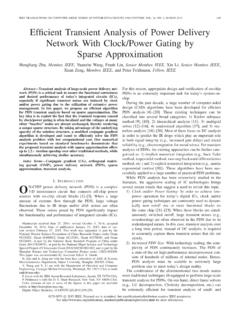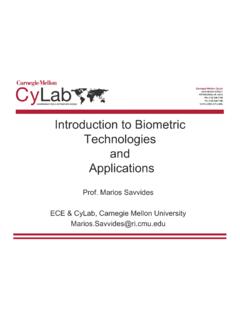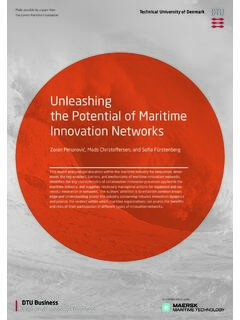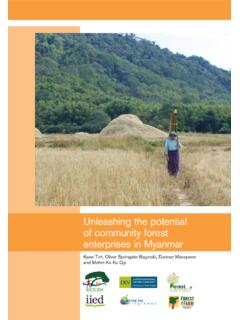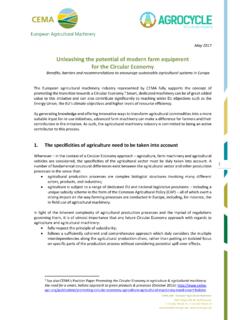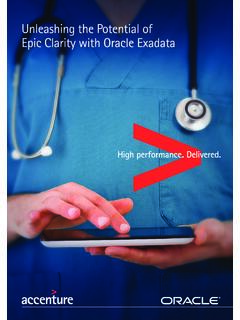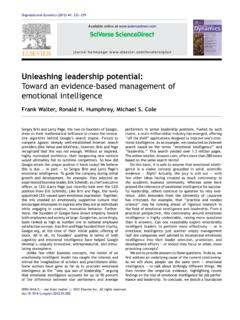Transcription of Unleashing the Potential of Data-Driven Networking
1 Unleashing the Potential of Data-Driven NetworkingJunchen Jiang , Vyas Sekar , Ion Stoica?+ , Hui Zhang + CMU,?UC Berkeley,+Conviva, last few years have witnessed the coming of age of data -drivenparadigm in various aspects of computing (partly) empowered by advances indistributed system research (cloud computing, MapReduce, etc). In this paper,we observe that the benefits can flow the opposite direction: the design and man-agement of networked systems can be improved by Data-Driven paradigm. Tothis end, we present DDN, a new design framework for network protocols basedon Data-Driven paradigm. We argue that DDN has the Potential to significantlyachieve better performance through harnessing more data than one single , we systematize existing instantiations of DDN by creating a uni-fied framework for DDN, and use the framework to shed light on the commonchallenges and reusable design principles.
2 We believe that by systematizing thisparadigm as a broader community, we can unleash the unharnessed Potential IntroductionAsk not what Networking can do for data ;Ask what data can do for Networking !Most networked applications require some form of control and adaptation logicto respond to changing network conditions. Traditionally, such control and adaptationstrategies in application and transport protocols have come to rely on aper-session1viewand usingmanually designedstrategies. For instance, TCP congestion control re-lies on many human-picked constants ( , initcwnd, AIMD parameters) and is drivenby feedback ( , acks, ECN) observed within the current flow. In some sense, this de-facto design template has been passed down across generations of designers as a form ofconventional wisdom drawn from lessons ( , end-to-end principles [50], congestioncollapse [28]) from the early days of the this conventional wisdom has indeed served us well for decades, today weface a confluence of use case pulls that increasingly make such approaches ineffec-tive: First, we seegrowing expectationsof user-perceived Quality of Experience (QoE) [31].
3 Thus, conventional approaches that worked well for a best effort mentality are nolonger good enough!1A session could be an application session ( , video session, web session), or a transportsession ( , TCP session). Second, we observe agrowing decision spaceof Potential control decisions to opti-mize application quality. Consequently, trial-and-error strategies driven by single-session feedback are fundamentally inefficient and slow in exploring the decisionspace and reacting to changes. For instance, it takes a video player several chunks(roughly 10s of seconds) to converge to an optimal combination of CDN and bi-trate [7]. Third, we see anincreasing heterogeneityin operating conditions, each requiringdifferent control logic and parameters. For instance, TCP parameters such as ini-tial congestion window and AIMD parameters could be tweaked to work better indifferent operating conditions [57, 20].
4 Tackling these challenges requires us to radically rethink the design of the con-trol plane of network protocols. In this context, we observe an opportunity for a newparadigm, which we refer to asData- driven Networking or DDN, inspired in part bythe successes in other aspects of computing driven by the ability to collect and extractinsights from large corpus of data [16, 25]. DDN transforms the design of the controlplane of network protocols by the availability of massive data from millions of end-points and devices. This is orthogonal to recent efforts to optimize the data planes ,such as ICN [29]. More specifically, a DDN-based control loop is driven by real-timemulti-session(not single-session) view ofin-situ quality[23] measurement (not activemeasurements or indirect metrics), andautomaticallytuned actuation algorithms basedon Data-Driven insights with little to no manual tuning.
5 For instance, to apply the conceptof DDN to optimize quality for video streaming, one can think of a controller that takesas input the quality measurements of millions concurrent and history video clients, anduse such data to automatically learn the best configuration such as server/CDN/cache,bitrate, and network path for each parallel to the use-case pulls described above, we also observe that DDN fortu-itously has key technology pushes that are suitably aligned. Specifically, many ap-plication providers today have widely deployed client-side instrumentation to collectreal-time performance data [23], and big data processing capabilities are finally areality [6].We are already seeing point evidence of this paradigm shift starting to reach theshores of many networked applications. This includes work in optimizing Internet videostreaming ( , [32, 24]), Internet telephony ( , [30]), cloud service availability ( , [39]), data center scheduling ( , [56]), congestion control ( , [51, 18, 57]), and networkmanagement ( , [15]), as well as industrial initiatives ( , [2, 8]).
6 To fully unleash the Potential of DDN, however, we identify key challenges span-ning a wide spectrum: (1) algorithms and machine learning ( , tackling high dimen-sionality, data sparsity, and exploration-exploitation tradeoffs), (2) system design ( ,balancing scalability, responsiveness and staleness), and (3) broader architectural ques-tions ( , stability and interactions with other possibly competing control loops). Un-fortunately, the aforementioned early DDN efforts suffer fundamental shortcomingsthat ultimately undermines the full Potential of this paradigm: First, each of these efforts offers point solutions tackling a small subset of DDNchallenges (tied to specific workload assumptions) and as such does not focus ongeneralizablealgorithmic or system-design insights for future DDN-based deploy-ments.
7 For instance, can these primitives ( , quality-determining features learnedby CFA [32] + split control plane from C3 [24] + exploration-exploration strategyfrom VIA [30]) be composed and if so how? Are these missing any hidden aspects; , how to ensure control stability or handle flash crowds? Second, they present techniques under application-specific assumptions and it isunclear if, why, and by how much they could benefit other applications. For in-stance, CFA assumes that video quality-determining features are persistent, whileVIA assumes that VoIP quality distribution between the same source and destina-tion ASes depends only on relay servers, and it is not obvious if these are necessaryor sufficient, or how much the benefit would be if we relax these than develop yet-another point solution to a narrow application, this papertakes afirst-principlesapproach to help democratize the Potential benefits of the DDNparadigm to a broader spectrum of use cases.
8 To that end, this paper makes two contri-butions:1. Formalizing DDN ( 2).We define key features that distance DDN from alternatives,provide illustrative examples of when DDN benefits, and generalize the design space aswell as the use cases of Common building blocks ( 3).We sketch a common platform for socializing thebenefits of DDN by developing key building blocks. We articulate four high-level tech-nical challenges, which are still open: how to extrapolate Potential benefits of DDN,infer optimal decisions with sparse data , implement real-time feedback loops at scale,and stabilize DDN control behaviors. We also see an opportunity of adapting abstrac-tions and techniques from machine learning and control theory, and we offer promisingprescriptive roadmap to address the Formalizing DDNIn this section, we give a conceptual overview of DDN, contrasting it to traditionalapproaches.
9 We present early evidence from prior work on the case for DDN. We endthis section by identifying key factors that can impact the Potential benefits of What is DDN?DDN is a new paradigm for designing the control plane of network protocols. It consistsof two components: (a) theclient-side instrumentationintegrates with the client-sideapplication2to measure client-perceived quality and apply decisions made by DDN;and (b) theDDN controllerruns two loosely coupled steps:1. Aggregate quality measurement from client-side instrumentation into amulti-sessionview a representation for summarizing the performance of similar Make control decisions based on the multi-session views, and send them to client-side understand the contrast between DDN and traditional control planes, it is usefulto revisit the two logical steps in the workflow ofanycontrol plane (Figure 1):sensing,2We use client to denote where a session is actually )DDN*control*planeDDN#control#planeSensi ngMulti0session#view#of#quality#perceive d#by#real#clientsAutomatically#tuned#by# data0driven#insightsSingle)session*view/ indirect*signals/active*measurementHandc rafted*logic¶metersFig.
10 1:DDN control plane is fundamentally different to non-DDN ones on both sens-ing and gives the feedback data to control plane, andactuation, which turns the feedbackdata to control decisions. DDN radically departs from non-DDN designs on both frontswith three definitive features. (Table 1 provides some examples to contrast betweenDDN and non-DDN designs.) Multi-session view:Sensing of DDN is based on multiple sessions, rather thansingle session. By extending the spatial scope of sensing to many sessions, DDNcan predict the quality of a decision even before a session actually uses it, as longas the decision has been used by some similar sessions. In-situ quality:In DDN, what to be sensed is exactly what to be optimized, , quality perceived by all historical and ongoing sessions; not indirect signalson quality ( , acks [28] or bandwidth [37]), or active probes from a handful ofvantage points ( , iPlane [42]).
